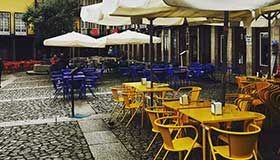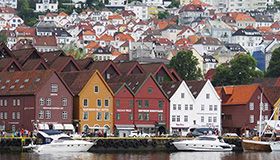The trip brochure calls it the “greatest voyage in natural history.” After spending several days visiting the Peruvian Amazon with 14 other Badger travelers, I have no reason to disagree. While our journey to the Amazon certainly did not involve the hardships of Theodore Roosevelt’s expedition as chronicled in the book The River of Doubt, it was not without its share of adventure, exploration, and wonder. The variety of flora and fauna we observed during our 680-mile journey was simply mind-boggling (and far too expansive to recount in this brief journal). From pygmy marmosets and piranhas to blue macaws and anacondas, our heads were seemingly always spinning as we repositioned in our skiffs to observe yet another species spotted by our expert naturalist guides and expedition leader.
A unique experience for several of our Wisconsin travelers was a stay at Ceiba Tops lodge and a visit to the Yanamono Medical Clinic. Founded by Linnea Smith ’81, MD’84, a Wisconsin Alumni Association (WAA) Distinguished Alumni Award winner, the clinic has provided medical services (Smith calls it “jungle medicine”) to the indigenous people of the Peruvian Amazon since 1990. Even though the recently reconstructed clinic is spartan compared to the facilities that we have in the U.S., Smith and her team simply find a way to make it work through their ingenuity, compassion, and dogged determination.
While the natural wonders of the Amazon are billed (rightfully so) as the “stars of the show,” a highlight for many of our travelers was the opportunity to learn more about the region’s culture and experience it firsthand. In addition to outstanding musical performances by our guides and the ship’s crew, Peruvian cooking lessons, and lectures on board our ship, La Estrella Amazonica, we also had the pleasure of visiting several local villages. During those visits, we were greeted warmly by the local ribereños (including a highly respected shaman), as well as by a community of indigenous Yagua people. (Have you ever shot a blowgun? Let’s just say that our Traveling Badgers know what they’re doing when it comes to handling this primitive — yet surprisingly powerful and accurate — hunting apparatus.)
Of course, no WAA tour is complete without a celebration of Badger spirit. That spirit was clearly visible throughout the week — as evidenced by the number of UW-Madison hats, T-shirts, and lapel pins sported by our group — but there were a couple of moments when it was on full display.
In the community of Once de Agosto, for instance, we visited a local school. As is common in the smaller villages along the Peruvian Amazon, grades one through six attend classes together in a single-room building. Although classes were not in session during our visit, we were still greeted by several students who proudly showed us their school and sang for our group. When asked to sing to them in return, we responded in kind with a resounding rendition of “On, Wisconsin!” (I think we have the makings of top-notch vocal group. There was some real talent among our travelers!)
As our trip was winding down (in terms of duration, but certainly not in enthusiasm), we gathered for a Founders’ Day celebration to commemorate the first class at the nascent University of Wisconsin: when 20 students gathered in a 720-square-foot classroom on February 5, 1849. It’s almost incomprehensible to think that what started from such humble beginnings was being celebrated by singing “Varsity” more than 3,000 miles away and 166 years later. Although we started the trip as relative strangers, we finished it as friends. The Badger spirit is truly alive and well!







